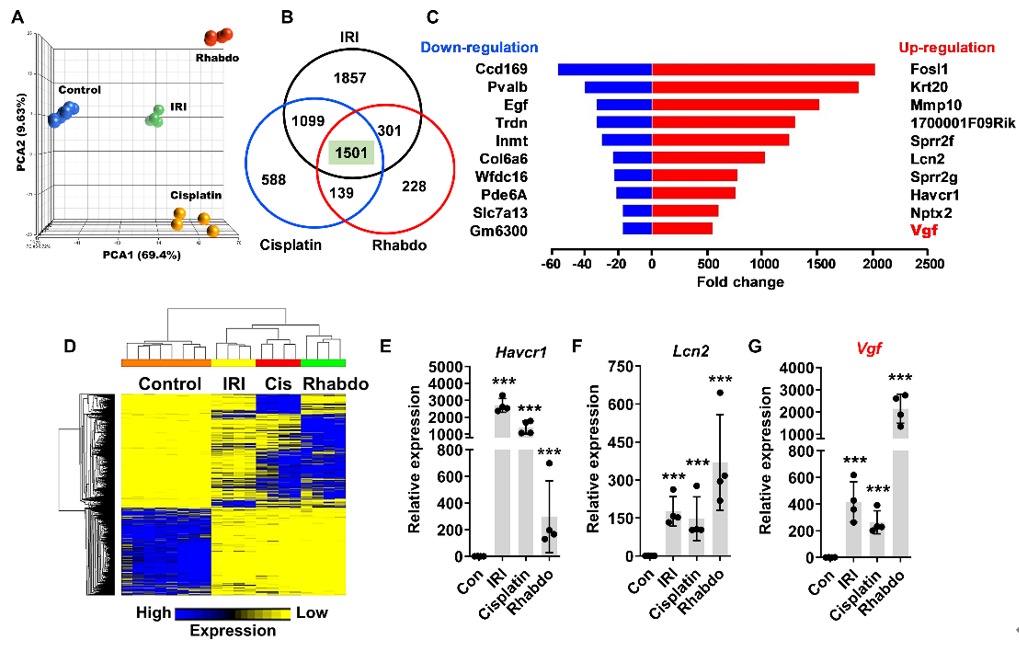Acute kidney injury (AKI) is a common clinical condition associated with diverse etiologies and abrupt loss of renal function. In patients with sepsis, rhabdomyolysis, cancer, and cardiovascular disorders, the underlying disease or associated therapeutic interventions can cause hypoxia, cytotoxicity, and inflammatory insults to renal tubular epithelial cells (RTECs), resulting in the onset of AKI. To uncover stress-responsive disease-modifying genes, here we have carried out renal transcriptome profiling in three distinct murine models of AKI. We find that Vgf nerve growth factor inducible gene up-regulation is a common transcriptional stress response in RTECs to ischemia-, cisplatin-, and rhabdomyolysis-associated renal injury. The Vgf gene encodes a secretory peptide precursor protein that has critical neuroendocrine functions; however, its role in the kidneys remains unknown. Our functional studies show that RTEC-specific Vgf gene ablation exacerbates ischemia-, cisplatin-, and rhabdomyolysis-associated AKI in vivo and cisplatin-induced RTEC cell death in vitro. Importantly, aggravation of cisplatin-induced renal injury caused by Vgf gene ablation is partly reversed by TLQP-21, a Vgf-derived peptide. Finally, in vitro and in vivo mechanistic studies showed that injury-induced Vgf up-regulation in RTECs is driven by the transcriptional regulator Sox9. These findings reveal a crucial downstream target of the Sox9-directed transcriptional program and identify Vgf as a stress-responsive protective gene in kidney tubular epithelial cells.

n the Figure, Transcriptome analysis of AKI-associated differentially expressed genes. Renal cortical tissues from control (mock and vehicle-treated) mice and mice undergoing AKI (IRI, cisplatin nephrotoxicity, and rhabdomyolysis) were utilized for transcriptome analysis. A, principal component analysis of bulk RNA-Seq data from control (n = 8) and AKI (n = 4) groups showed that biological replicates clustered together across groups, signifying a high degree of similarity. B, Venn diagram depicting common differentially expressed genes in the AKI groups. In the three AKI groups, a common set of 1501 genes were found to differentially expressed as compared with control group. C, graphical depiction of top up- and down-regulated genes in three distinct AKI models. D, heatmap of differentially expressed genes during AKI. E–G, gene expression analysis of Havcr1, Lcn2, Vgf genes showed injury-induced up-regulation. In all (E–G) the bar graphs (n = 4 biologically independent samples), experimental values are presented as mean ± S.D. The height of error bar = 1 S.D., and p < 0.05 was indicated as statistically significant. One-way ANOVA, followed by Dunnett's (E–G), was carried out, and statistical significance is indicated by *p < 0.05, **p < 0.01, ***p < 0.001.
Quick Biology provided the service of the RNAseq sequencing for this study.
RNA sequencing (RNA-Seq) has revolutionized the exploration of the transcriptome. Advances in the RNA sequencing workflow, from sample preparation through data analysis, enable rapid profiling and deep investigation of the RNA. As a professional RNA-Seq service provider, Quick Biology is able to provide a fast turnaround time (10-20 business days) and a very competitive price for RNA-seq.
Quick Biology is a professional RNASeq provider and will ensure the customer to get the most out of the sequencing project.
See resource:
Ji Young Kim, et al. SOX9 promotes stress-responsive transcription of VGF nerve growth factor inducible gene in renal tubular epithelial cells. Journal of Biological Chemistry (2020): jbc-RA120.



